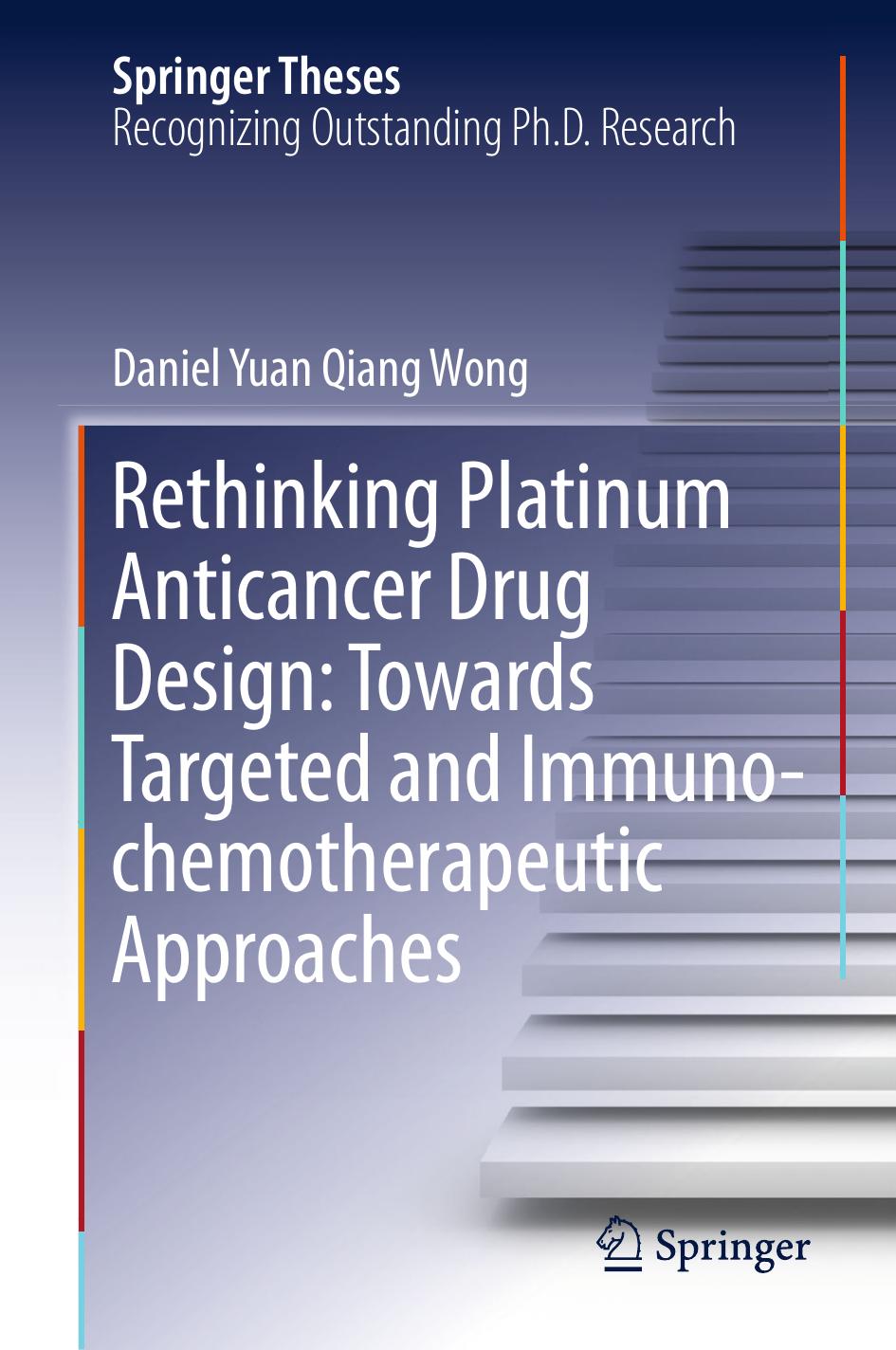Rethinking Platinum Anticancer Drug Design: Towards Targeted and Immuno-chemotherapeutic Approaches by Daniel Yuan Qiang Wong

Author:Daniel Yuan Qiang Wong
Language: eng
Format: epub, pdf
Publisher: Springer Singapore, Singapore
3.1 Introduction
Amongst the metallopharmaceuticals in development, platinum(IV) complexes are unique because they are native prodrugs of clinically-relevant platinum(II) pharmacophores such as cisplatin and oxaliplatin (Fig. 3.1) These platinum(II) drugs are some of the most effective anticancer agents in clinical use and the first line treatment for many malignancies today (Fig. 3.1) [1–3]. The general consensus is that these platinum(IV) prodrug complexes are themselves pharmacologically inactive and must undergo reductive elimination by endogenous reductants to release the active square-planar platinum(II) core with concomitant dissociation of the axial ligands (Fig. 3.2) [1–3]. As such, the axial ligands confers unique possibilities of tuning the pharmacokinetic parameters such as lipophilicity and solubility as well as the attaching any targeting groups or synergistic co-drugs without altering the cellular mechanism of action of the innate platinum(II) pharmacophore [1–3].
The key impetus driving this study is the uncertainty whether asymmetrical aryl platinum(IV) complexes bearing a cisplatin-type scaffold (cis,cis-diam(m)inedichlorido equatorial ligands), which we are developing several applications for, are indeed prodrugs of cisplatin [4]. Based on the literature, there have been mixed evidence for and against the hypothesis that cisplatin-type platinum(IV) complexes are prodrugs of cisplatin. The strongest support for prodrug hypothesis appeared to be extrapolated from extensive in vitro and in vivo studies from satraplatin [5, 6] and iproplatin [7] which bear the cis-am(m)ine(cyclohexylamine) and cis-diisopropylamine core respectively (Fig. 3.1). These studies showed that that the expected platinum(II) congener was indeed the predominant product of reduction via HPLC. However to date, the same has never been shown from a cisplatin-type platinum(IV) scaffold. Indeed, subtle variation of the equatorial ligands, such as equatorial replacement of 1,2-DACH (diaminocyclohexane) with a 1,4-DACH ligand can have a profound and unexpected influence on the reduction behaviour of platinum(IV) complexes [8]. It was also observed that trans-analog of satraplatin bearing trans-dichloro ligands favored an inner-sphere reduction mechanism, resulting in retention of the diacetate ligands and loss of the chloride ligands [9]. Another study suggested that reduction of certain classes of cis-platinum(IV) complexes including satraplatin may actually proceed via multiple pathways leading to the loss of any combination of axial carboxylate and equatorial chloride ligands [10, 11]. Consequently, 4 different reduction products were formed instead of the expected sole product.
Validation of the platinum(IV) prodrug hypothesis is important because it is the underlying working assumption behind much effort which has been directed towards the design of platinum(IV)-conjugates in recent years [3]. Very diverse examples of platinum(IV)-conjugates have been reported including conjugation to targeting peptides, [12, 13] synergistic co-drugs, [14–16] as well as to macromolecular delivery vehicles [17–20]. Invalidation of this central hypothesis would bear negative implications against this burgeoning field. For instance, we reported a method of hydrophobic entrapment to encase strongly hydrophobic platinum(IV) complexes bearing axial aryl carboxylates within multiwalled carbon nanotubes via hydrophobic-hydrophobic interactions [20]. The premise was that hydrophilic cisplatin would be released as a result of drastic hydrophobic reversal upon reduction. Such a strategy hinged upon the release of the axial benzoyl ligands rather than the chloride ligands. In addition, asymmetric acylation
Download
Rethinking Platinum Anticancer Drug Design: Towards Targeted and Immuno-chemotherapeutic Approaches by Daniel Yuan Qiang Wong.pdf
This site does not store any files on its server. We only index and link to content provided by other sites. Please contact the content providers to delete copyright contents if any and email us, we'll remove relevant links or contents immediately.
| Automotive | Engineering |
| Transportation |
Whiskies Galore by Ian Buxton(41879)
Introduction to Aircraft Design (Cambridge Aerospace Series) by John P. Fielding(33064)
Small Unmanned Fixed-wing Aircraft Design by Andrew J. Keane Andras Sobester James P. Scanlan & András Sóbester & James P. Scanlan(32743)
Craft Beer for the Homebrewer by Michael Agnew(18140)
Turbulence by E. J. Noyes(7936)
The Complete Stick Figure Physics Tutorials by Allen Sarah(7307)
Kaplan MCAT General Chemistry Review by Kaplan(6867)
The Thirst by Nesbo Jo(6827)
Bad Blood by John Carreyrou(6552)
Modelling of Convective Heat and Mass Transfer in Rotating Flows by Igor V. Shevchuk(6391)
Learning SQL by Alan Beaulieu(6211)
Weapons of Math Destruction by Cathy O'Neil(6146)
Man-made Catastrophes and Risk Information Concealment by Dmitry Chernov & Didier Sornette(5921)
Digital Minimalism by Cal Newport;(5664)
Life 3.0: Being Human in the Age of Artificial Intelligence by Tegmark Max(5474)
iGen by Jean M. Twenge(5366)
Secrets of Antigravity Propulsion: Tesla, UFOs, and Classified Aerospace Technology by Ph.D. Paul A. Laviolette(5309)
Design of Trajectory Optimization Approach for Space Maneuver Vehicle Skip Entry Problems by Runqi Chai & Al Savvaris & Antonios Tsourdos & Senchun Chai(5011)
Pale Blue Dot by Carl Sagan(4912)
